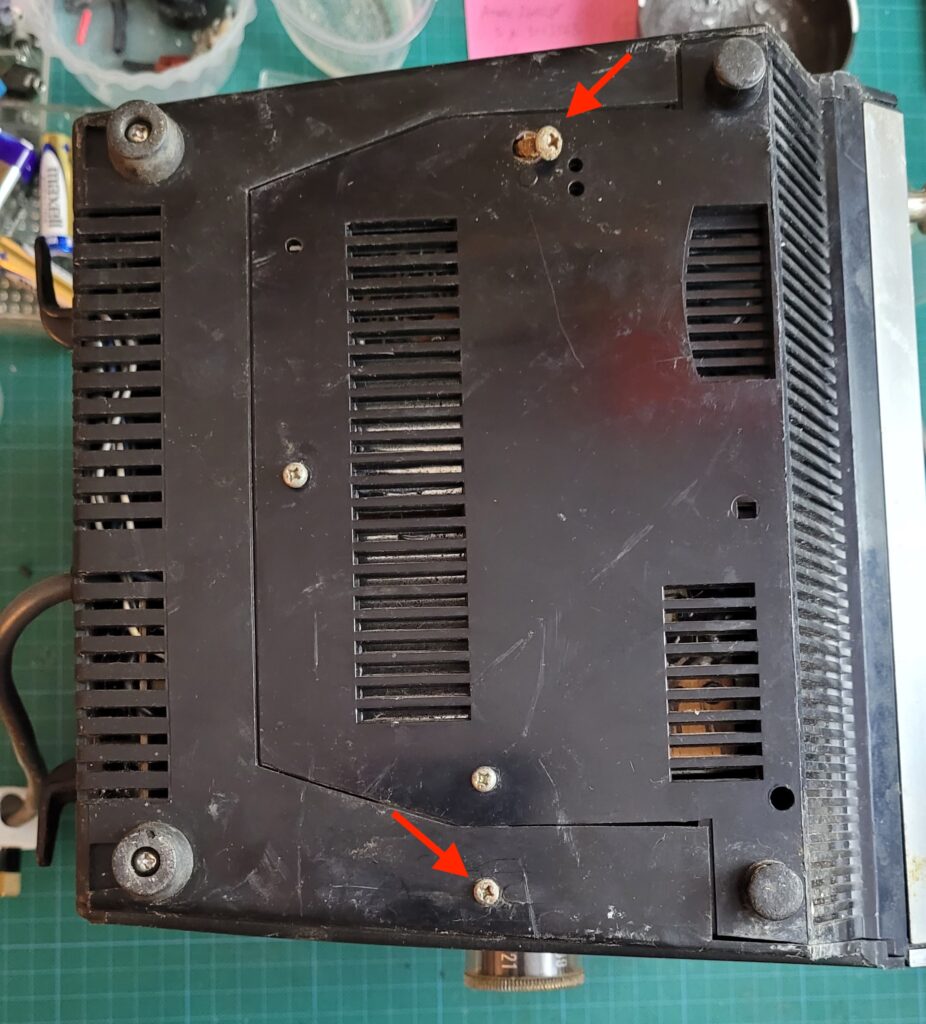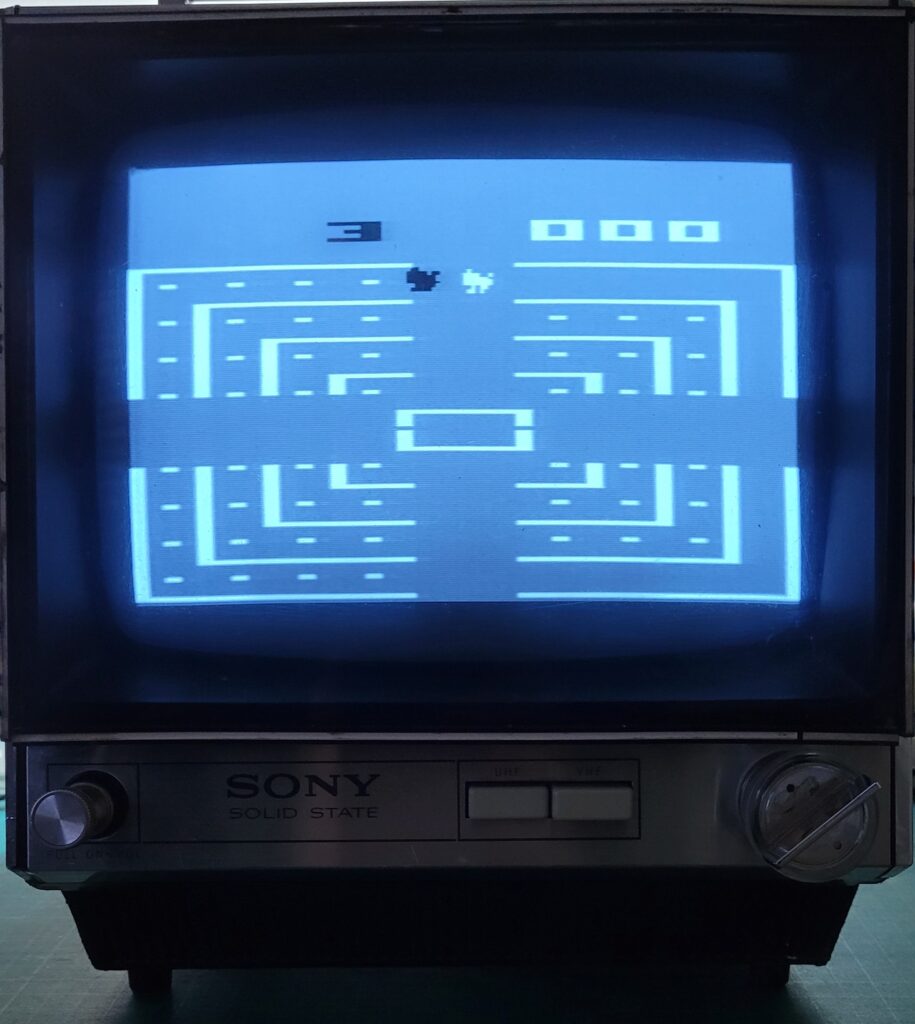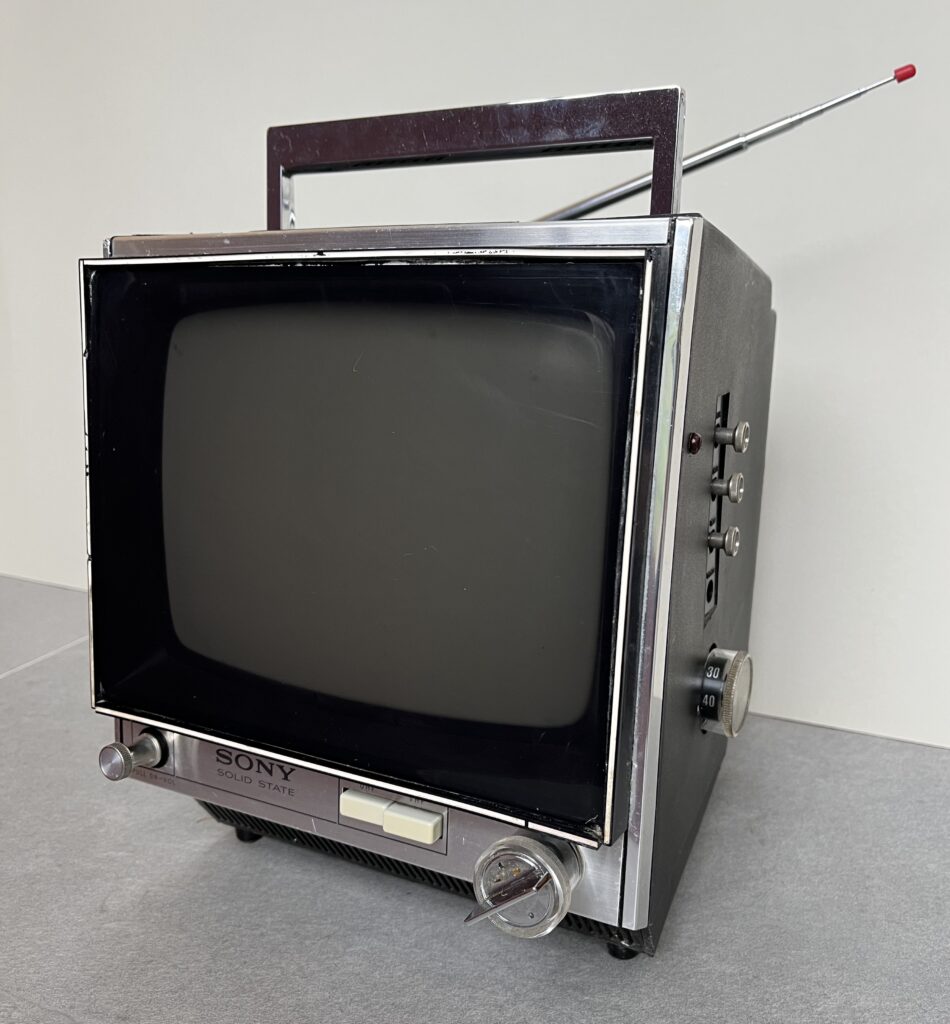Here’s an nice example of a small portable black and white TV made in Japan by the Sony Corporation in the 1960s. I picked up this one at Ardingly Antiques and Collectables fair a couple of years ago for £5 as a restoration project. It’s been sitting in a shed since and I pulled it out to help fault find a troublesome Atari 2600. More on the Atari in a later post.
The Sony CVM90UB or 9-90UB is solidly built and has only a few scars for its age. The black plastic case houses a 9 inch CRT with loudspeaker and can run from an external 12V battery. It has a built in transformer for mains power. There’s a telescopic aerial best suited for VHF plus an external aerial socket for more stable reception or connection to a retro games console.
There are two tuning controls, one on the side for UHF 625 line and one on the front panel for the long defunct VHF 405 line turret tuner. Push buttons on the front select UHF or VHF wavebands. Of course today you won’t find any analogue TV broadcast unlike the 1960s and 70s when dual standard analogue TV was all you could receive. Here in the UK that was limited to three channels BBC1, BBC2 and ITV.
Having 405 line capability may seem pointless, given there’s nothing being broadcast, but you may be amazed to learn British Heritage Television plan to revive test transmissions to support public education. And if you want to restore a vintage TV having a reliable transistorised set like the Sony to hand could be useful.
For a fifty year old TV the Sony’s picture is surprisingly good but needed a minor repair to see it working.
Warning – always disconnect the mains power before attempting to remove the case and beware that old TVs with CRTs use very high voltages that can remain charged after the power is removed.
No picture or sound
After a plug fuse and quick ohms check to ensure nothing unusual, I plugged the Sony in and pulled the volume control to switch the set on. Nothing happened. No hiss or glimmer from the picture tube.
I unplugged and checked the mains plug’s resistance with the switch still on and it measured high. I guessed the fuse may have blown or there was something worse lurking inside.
Removing a single screw from each side of the case, along with the fixings marked with a raised dot on the case (as shown below), I peered inside.

Rear fixings to remove

Base screws to remove
Be careful not to remove any other fixings from the rear as this can release the heavy transformer that could drop and damage the CRT. CRTs have a vacuum and can implode if the neck is fractured so be take care when attempting to access inside. If in doubt don’t!
Amid dust and cobwebs I could see a fuse and checked it was okay. So maybe the power switch was faulty?

Internal view of fuse and mains transformer
There were a pair of contacts on the end of the volume control which both measured a higher resistance than they should. I applied switch cleaner to the volume control gap in the hope it would find its way through to the switch contacts. It did. After repeated switch operation the resistance lowered and became stable.
With the case back in place and a second attempt at mains power, the set hissed into life. It took a few seconds for the tube to warm up and a faint raster emerged in an eerie glow. I wondered when it had last been seen.
Connecting a working Atari 2600 games console, I turned the UHF control to channel 36 and found Dodge ’em. It worked and after a tweak on the horizontal hold the grid showed.

Dodge ’em from Atari 2600
Beeps also emerged as I fumbled with the game pad. With the TV working , I plugged in another Atari that failed to display video on a modern TV. Unfortunately the 2600 junior displayed the same zig-zag lines and dots I’d seen on the modern TVs. I’d hoped the Sony, with it’s fine manual frequency control and hold adjustment may display the Atari’s video. Modern digital TVs don’t offer these tweaks that the accommodating analogue circuitry can.
At least the Sony TV worked and will be useful in future endeavours so I decided to tidy some of its patina. Here’s a brief list:
- Aerial fix – the telescopic aerial was missing it’s red tip so I repurposed a spare plastic peg from a pocket chess game which suited well. It was rather dangerous to poke eyes etc without the visible tip in place.
- Cleaning – First remove the internal plug linking the power supply in the rear case with the main chassis. This makes it easier to remove dust and debris without straining wires and damaging the CRT neck.
- Trim – a section of chrome trim had been lost from one side. These are glued in place and need a sharp blade or chisel to smooth away the old adhesive to recover. As a temporary repair, I used aluminium thermal wrap tape and plan to find some thicker chrome tape sold for auto door and bumper styling for be a better match.
- Control knobs – One of the four fine control knobs was missing and difficult to source replacements although some enthusiasts are producing 3D printed replicas – see UK Vintage Radio forum – Experiences with Sony 9-90UB. I cleaned the remaining set of three using a fibreglass buff tool that removed the greenish corrosion residue to reveal the gleaming nickel finish. Don’t breath in the fine dust the fibreglass can create – nickel (or whatever was used) can be an irritant. Both tuning knobs had years of use trapped inside the plastic surrounds. These were removed and soaked in detergent and cleaned with a tooth brush.
It’s handy to have an old TV to diagnose faulty games consoles like the Atari and Nintendo SES which only produced an RF output. Better still to have colour and I’ll be looking out for a Sony Trinitron or similar on our next visit to Ardingly or car boot.

Sony-9-90-UB TV
Associated links
Amazingly, the Sony CVM90UB is still popular and there are several sites featuring more details about this classic TV.
- Snellings Museum – Sony 9-90UB
- Reddit – Sony TV-9-90UM (1969) Repaired and Restored
- Radio Museum – TV 9-90UB


02/04/2024 at 8:25 am
Found my old sony tv and it still powers up! amazing for such old tech